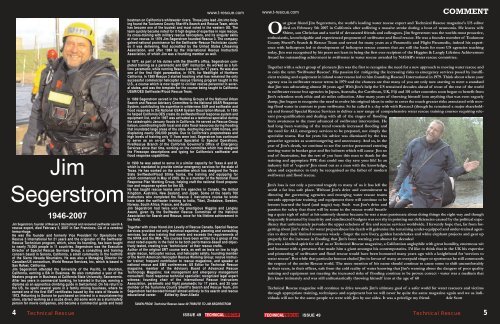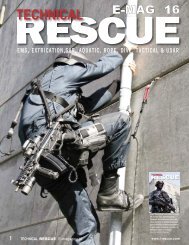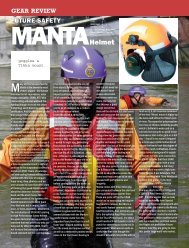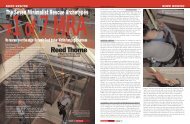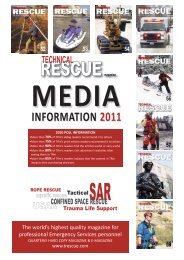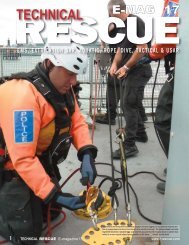Jim Segerstrom - Technical Rescue Magazine
Jim Segerstrom - Technical Rescue Magazine
Jim Segerstrom - Technical Rescue Magazine
You also want an ePaper? Increase the reach of your titles
YUMPU automatically turns print PDFs into web optimized ePapers that Google loves.
<strong>Jim</strong><br />
<strong>Segerstrom</strong><br />
1946-2007<br />
<strong>Jim</strong> <strong>Segerstrom</strong>, founder of <strong>Rescue</strong> 3 International and renowned swiftwater search &<br />
rescue expert, died February 5, 2007 in San Francisco, CA of a cerebral<br />
hemorrhage.<br />
He was the founder and formerly Vice President for Operations for<br />
<strong>Rescue</strong> 3 International for 21 years and the originator of the Swiftwater<br />
<strong>Rescue</strong> Technician program, which, since its founding, has been taught<br />
to nearly 70,000 people in 11 countries. <strong>Segerstrom</strong> was the Executive<br />
Director of Special <strong>Rescue</strong> Services Group, a consulting and training<br />
concern based in Sonora, California, a small community in the foothills<br />
of the Sierra Nevada Mountains. He was also a Managing Director for<br />
Canadian/US consortium, World <strong>Rescue</strong> Services, Inc, which is based in<br />
San Rafael, California.<br />
<strong>Jim</strong> <strong>Segerstrom</strong> attended the University of the Pacific, in Stockton,<br />
California, earning a BA in Business. He also completed a year of the<br />
Masters program in Business at California State University, Sacramento.<br />
After two years in commercial banking, he traveled in Europe, earning a<br />
diploma as an apprentice climbing guide in Switzerland. On his return to<br />
the US, he spent several years in a family mining business, where he<br />
earned one of the first EMT certificates issued by the state of Nevada in<br />
1973. Returning to Sonora he purchased an interest in a mountaineering<br />
store, started working as a scuba diver, did some work as a stunt/safety<br />
person for movie companies, and became a commercial guide and head<br />
www.t-rescue.com<br />
boatman on California's whitewater rivers. Those jobs lead <strong>Jim</strong> into helping<br />
found the Tuolumne County Sheriff's Search and <strong>Rescue</strong> Team, which<br />
has become one of the busiest and most noted in the western US. The<br />
team quickly became noted for it high degree of expertise in rope rescue,<br />
its cross-training with military rescue helicopters, and its singular skills<br />
at river rescue. In 1979 <strong>Jim</strong> <strong>Segerstrom</strong> founded <strong>Rescue</strong> 3. The company<br />
gained national prominence for the Swiftwater <strong>Rescue</strong> Technician courses<br />
it was delivering, first accredited by the United States Lifesaving<br />
Association, and after 1984 by the International <strong>Rescue</strong> Instructors<br />
Association, of which <strong>Jim</strong> was a founding member as well.<br />
In 1977, as part of his duties with the Sheriff's office, <strong>Segerstrom</strong> completed<br />
training as a paramedic and EMT instructor. He worked as a fulltime<br />
paramedic, while running <strong>Rescue</strong> 3 as well, for 17 years. He was also<br />
one of the first flight paramedics, in 1978, for Mediflight of Northern<br />
California. In 1980 <strong>Rescue</strong> 3 started teaching what has remained the only<br />
successful commercial helicopter rescue training program taught in the<br />
U.S., a course which is now taught to civilian rescue personnel in several<br />
states, and was the template for the course being taught to California<br />
USAR/OES Swiftwater/Flood <strong>Rescue</strong> Team.<br />
In 1989 <strong>Segerstrom</strong> served in the Working Groups of the National Urban<br />
Search and <strong>Rescue</strong> Advisory Committee to the National USAR Response<br />
System, contributing his expertise in wilderness SAR and swiftwater and<br />
flood response to the National USAR System Description Manual. In 1995<br />
he helped California OES create its swiftwater/flood response system and<br />
equipment list, and in 1997 was activated as a technical specialist during<br />
the catastrophic January floods in California. He served as <strong>Rescue</strong> Group<br />
liaison, coordinating both local and state flood resources during flooding<br />
that inundated large areas of the state, destroying over 5000 homes, and<br />
displacing nearly 200,000 people. Due to California's preparedness and<br />
high levels of training only 11 lives were lost. <strong>Segerstrom</strong> has continued<br />
to serve as an on-call <strong>Technical</strong> Specialist to Special Operations,<br />
Fire/<strong>Rescue</strong> Branch of the California Governor's Office of Emergency<br />
Services since that time, working on the committee which has designed<br />
the Firescope descriptions and typing for California's swiftwater and<br />
flood response capabilities.<br />
In 1999 he was asked to serve in a similar capacity for Texas A and M,<br />
which is mandated to provide similar emergency services for the state of<br />
Texas. He has worked on the committee which has designed the Texas<br />
State Swiftwater/Flood Strike Teams, the training and equipping for<br />
which commenced in May of 2000. He is a member of the National Flood<br />
Response Plan Working Group, helping craft the national flood preparation<br />
and response system for the US.<br />
He has taught rescue teams and fire agencies in Canada, the United<br />
Kingdom, Australia, New Zealand, and Japan. Some of the nearly 700<br />
instructors who completed the <strong>Rescue</strong> 3 instructors course he wrote<br />
have taken the swiftwater training to India, Tibet, Zimbabwe, Sweden,<br />
Norway, South Africa, France, and Austria.<br />
<strong>Jim</strong> <strong>Segerstrom</strong> had twice won the prestigious Higgins and Langley<br />
Award, given by the Swiftwater <strong>Rescue</strong> Committee of the National<br />
Association for Search and <strong>Rescue</strong>, once for his lifetime achievement in<br />
the field.<br />
Together with close friend <strong>Jim</strong> Lavally of <strong>Rescue</strong> Canada, Special <strong>Rescue</strong><br />
Services provided not only technical expertise, planning and consulting<br />
services, but also training that meets and exceeds the requirements of<br />
the NFPA and the IRIA. The courses have been written by a group of the<br />
most noted experts in the field to be both performance-based and objectively<br />
tested, creating true "technicians" at their rescue crafts.<br />
Author of the original SRT course texts, as well as texts on low to high<br />
angle rescue, helicopter rescue, and helicopter safety; founding member<br />
of the North American Helicopter <strong>Rescue</strong> Working Group; rescue instructor<br />
trainer; frequent contributor to rescue magazines, and speaker at<br />
national rescue and EMS conferences; US Editor for <strong>Technical</strong> <strong>Rescue</strong><br />
magazine, member of the Advisory Board of Advanced <strong>Rescue</strong><br />
Technology <strong>Magazine</strong>; risk management and emergency management<br />
consultant; flood response technical specialist; recognized legal expert<br />
witness; founding chair of the International <strong>Rescue</strong> Instructors<br />
Association, paramedic and flight paramedic for 17 years, and 25 year<br />
member of the Tuolumne County Sheriff's Search and <strong>Rescue</strong> Team, <strong>Jim</strong><br />
<strong>Segerstrom</strong> had devoted himself almost entirely to his search and rescue<br />
educational career. Edited by Sean Alladio<br />
TAKEN FROM <strong>Technical</strong> <strong>Rescue</strong> issue 49 TRIBUTE TO JIM SEGERSTROM<br />
www.t-rescue.com<br />
COMMENT<br />
Our great friend <strong>Jim</strong> <strong>Segerstrom</strong>, the world’s leading water rescue expert and <strong>Technical</strong> <strong>Rescue</strong> magazine’s US editor<br />
died on February 5th 2007 in California after suffering a massive stroke during a bout of neumonia. He leaves wife<br />
Shiree, son Christian and a world of devastated friends and colleagues. <strong>Jim</strong> <strong>Segerstrom</strong> was the worlds most proactive,<br />
enthusiastic, knowledgable and experienced proponent of swiftwater and flood rescue. He was a founder member of Toulumne<br />
County Sherrif's Search & <strong>Rescue</strong> Team and served for many years as a Paramedic and Flight Paramedic, indeed his experience<br />
with helicopters led to development of helicopter rescue courses that are still the basis for most US agencies teaching<br />
today. <strong>Jim</strong> was recognised by his peers not least in being the first ever recipient of the Higgins & Langly Lifetime Achievement<br />
Award for outstanding achievment in swiftwater in water rescue awarded by NASAR’s water rescue committee.<br />
Together with a select group of pioneers <strong>Jim</strong> was the first to recognise the need for a new approach to moving water rescue and<br />
to coin the term ‘Swiftwater <strong>Rescue</strong>’. His passion for mitigating the increasing risks to emergency services posed by insufficient<br />
training and equipment in inland water rescue led to him founding <strong>Rescue</strong>3 International in 1979. Think about where your<br />
agency was in swiftwater rescue terms in 1979 and the chances are that many of you are only now starting to meet a standard<br />
that <strong>Jim</strong> was advocating almost 30 years ago! With <strong>Jim</strong>’s help the US remained decades ahead of most of the rest of the world<br />
in swiftwater rescue but agencies in Japan, Australia, the Carribean, UK, Fiji and 101 other countries soon began to benefit from<br />
<strong>Jim</strong>’s relentless work ethic and air miles collection. After many years of throwing himself into anything that was even vaguely<br />
damp, <strong>Jim</strong> began to recognise the need to evolve his original ideas in order to cover the much greater risks associated with moving<br />
flood water in contrast to pure swiftwater. So he called it a day with with <strong>Rescue</strong>3 (though he remained a major shareholder)<br />
and formed Special <strong>Rescue</strong> Services to deliver a new range of comprehensive water rescue training courses requiring relevant<br />
pre-qualification and dealing with all of the stages of flooding<br />
from awareness to the most advanced of swiftwater intervention. He<br />
had long been warning of the trend towards increased flooding and<br />
the need for ALL emergency services to be prepared, not simply the<br />
specialist teams. But for years his advice was dismissed by the less<br />
proactive agencies as scaremongering and unecessary. And so, in the<br />
year of <strong>Jim</strong>’s death, we continue to see fire service personnel entering<br />
moving water in bunker gear and fire helmets which will cause <strong>Jim</strong> no<br />
end of frustration, but the rest of you have this man to thank for the<br />
training and appropiate PPE that could one day save your life! In an<br />
industry full of ‘experts’ <strong>Jim</strong> stood out as a man with the knowledge,<br />
ideas and experience to truly be recognised as the father of modern<br />
swiftwater and flood rescue.<br />
<strong>Jim</strong>’s loss is not only a personal tragedy to many of us it has left the<br />
world a far less safe place. Without <strong>Jim</strong>’s drive and commitment to<br />
directing the governing agencies and emerging water rescue teams<br />
towards appropriate training and equipment there will continue to be<br />
lessons learned the hard (and tragic) way. Such was <strong>Jim</strong>’s drive and<br />
passion for safety that there will be some in the rescue world breathing<br />
a quiet sigh of relief at his untimely demise because he was a man passionate about doing things the right way and though<br />
frequently frustrated by inactivity and misdirected budgets was not shy in pointing out deficiencies caused by the political expediency<br />
that unfortunately pervades the upper echelons of fire and rescue services worldwide. I fervently hope that, far from forgetting<br />
about <strong>Jim</strong>’s drive for water preparedness his death will galvanise the remaining under-equipped and under-trained agencies<br />
to drect their limited resources wisely - forget the new livery, golden handshakes and white elephant projects and gear up<br />
properly for the increase in flooding that <strong>Jim</strong>’s been warning you aboout for decades!<br />
<strong>Jim</strong> was a kindred spirit for all of us at <strong>Technical</strong> <strong>Rescue</strong> magazine, a Californian anglophile with great humility, enormous wit<br />
and humour with a presence that made him a giant amongst his contemporaries. I’d like to think that in the UK his expertise<br />
and pioneering of swiftwater and flood rescue would have been honoured many years ago with a knighthood for ‘services to<br />
water rescue’. But while that particular honour eluded <strong>Jim</strong> in favour of many an overpaid singer or sportsman he still commands<br />
the respect of the entire <strong>Rescue</strong> world. The mere mention of his name should continue to cause some to shift uncomfortably<br />
in their seats, in their offices, safe from the cold reality of water knowing that <strong>Jim</strong>’s warning about the dangers of poor quality<br />
training and equipment not meeting the increased risks of flooding continue to be proven correct - water was a medium that<br />
<strong>Jim</strong> knew intimately and was still enthusiastically throwing himself into at the age of 60<br />
<strong>Technical</strong> <strong>Rescue</strong> magazine will continue to drive towards <strong>Jim</strong>’s ultimate goal of a safer world for water rescuers and victims<br />
through appropriate training, techniques and equipment but we will never be quite the same magazine again and we as individuals<br />
will not be the same people we were with <strong>Jim</strong> by our sides. It was a privelige my friend. Ade Scott<br />
4 <strong>Technical</strong> <strong>Rescue</strong> magazine ISSUE 49 TECHNICALrescue<br />
TECHNICALrescue ISSUE 49<br />
<strong>Technical</strong> <strong>Rescue</strong> magazine5
GALLERY<br />
GALLERY<br />
JIM SEGERSTROM 1946 - 2007<br />
This was <strong>Jim</strong> in his element - enthusiastic<br />
Fijian whitewater rafters with absolutely no<br />
pre-conceptions or political allegiances listen<br />
to the master and then implement what they<br />
have learnt. <strong>Jim</strong> was justifiably proud of the<br />
work he did in the the more remote regions of<br />
the world improving safety and efficiency of<br />
rescuer and victims alike. Most recently he<br />
had worked in Jamaica and Haiti.<br />
Top: <strong>Jim</strong> kits up. This pic: <strong>Jim</strong> in blue wtesuit sizes up the task. <strong>Jim</strong>’s<br />
home patch with the Tuolumne County SAR Team was Sonora and the surrounding<br />
wilderness in northern California. This incident was the last <strong>Jim</strong><br />
attended and was a convoluted body search which we detail in issue 49.<br />
<strong>Jim</strong>’s favourite web-pic: he would send<br />
this to all and sundry with the strapline:<br />
‘Panic in Ireland as floodwaters rise’<br />
<strong>Jim</strong>s Memorial Service was held in his home town of Sonora. Ca. With state and National Flags draped and unfurled Washington Street, the main Sonora thoroughfare, was<br />
closed for <strong>Jim</strong>s procession. This included vehicles from the Fire dept, Sheriff’s dept and <strong>Rescue</strong> Team. It was an event attended by friends and colleagues from literally all corners<br />
of the globe with personal readings by brothers Donald, David, Steven and his sister Ann. Great friends <strong>Jim</strong> Lavally and TCSAR Team leader Barry Edwards also spoke<br />
and <strong>Jim</strong> was given an ‘official’ send-off with a 21-gun salute and a helicopter fly-past in the fallen comrades flight pattern. <strong>Jim</strong> is survived by wife Shiree and son Christian.<br />
6 <strong>Technical</strong> <strong>Rescue</strong> magazine<br />
www.t-rescue.com<br />
www.t-rescue.com<br />
Above: <strong>Jim</strong> was a major driving force in the<br />
Higgins & Langley Awards and Swiftwater<br />
Challenge and is going to be a hard act to<br />
follow!!<br />
<strong>Technical</strong> <strong>Rescue</strong> magazine7


